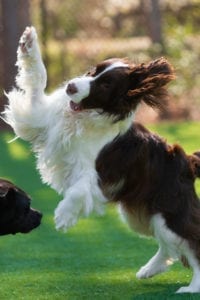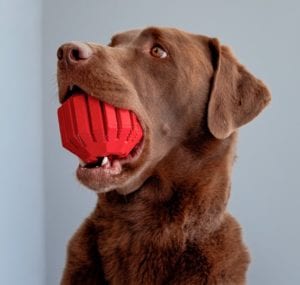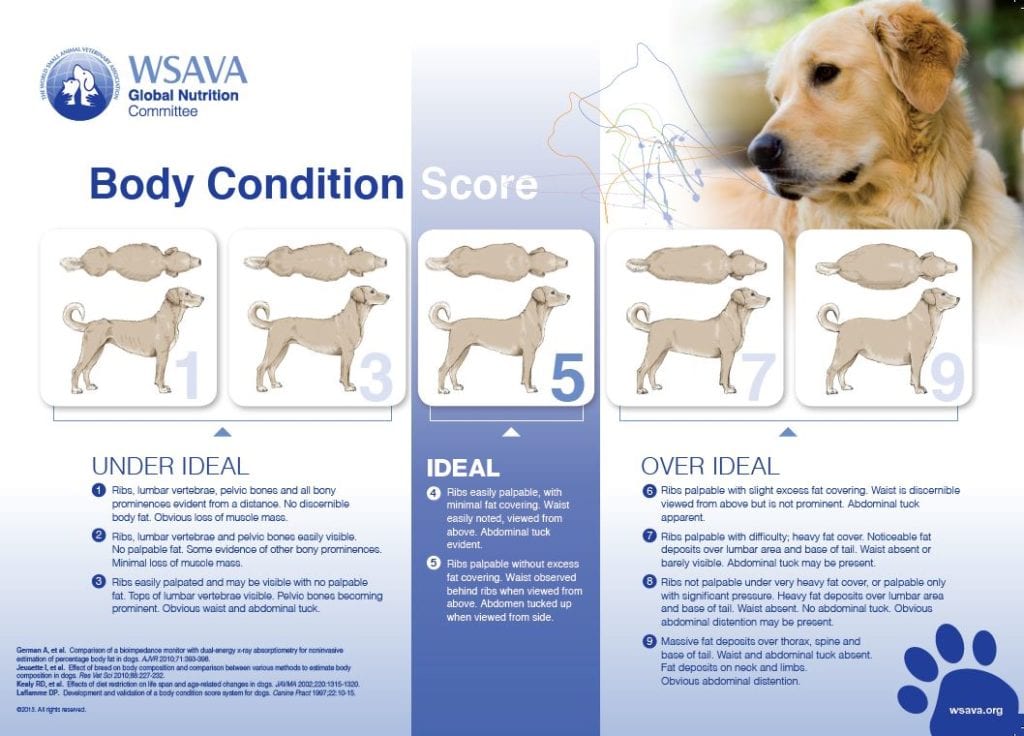In the US, roughly 1 in 3 dogs is overweight or obese. Dogs gain weight when they eat more food than they burn off in activities. That boils down to “too many treats, not enough walks.”
Health Impact of Obesity
Excess fat contributes to inflammation, and inflammation contributes to health problems in dogs just as it does in people.
Obesity in dogs is associated with joint damage, diabetes, urinary disorders, some tumors, some skin problems, pancreatitis, respiratory disorders, more risks if the dog needs anesthesia, and a shortened life span. Medium and large breed dogs who get very much larger than ideal have trouble getting into cars, making it difficult to transport them to the vet, to daycare, or to a boarding kennel.
Healthy-weight dogs live 1.8 years longer, on average, than overweight dogs; they have delayed onset of numerous disease conditions, and their quality of life is enhanced.
Denial about Our Dog’s Weight
Many people have trouble recognizing that their dog is overweight, and this is as true for healthy weight people as it is for people who are themselves overweight.
Body condition scoring is used to define an optimal body weight. Dogs with a healthy body condition score (defined as a 4-5/9 on a 9 point scale) will have a definite waist from above, the last 2-3 ribs are visible and easily felt, and an abdominal tuck is noted from the side view.
It can be easy to pretend a dog isn’t fat, especially for small stockier bully breeds and mixes. Humans don’t think much of the difference between 9 pounds and 11 pounds. However, that could be 20% of the animal’s ideal weight. On a person, that could easily be 30 or 40 pounds, and you know you won’t fit into the same jeans at the top of that range as you will at the bottom!
Document Your Pet Feeding and Talk with Your Vet
If you’re not sure about whether your dog is at a healthy weight, ask your vet. Measure what you feed, and follow the feeding instructions. Bring a picture of the food labels of what you are feeding, showing the ingredients and instructions to your vet. Do the same for treats too. Don’t be surprised if your vet tells you to break one treat into several smaller pieces. Your dog is just as happy to get a treat, and a smaller treat has fewer calories.
Many low calorie treats (under 5 kcal/treat) are available today. If you don’t see calorie information, please don’t buy the treats.
3 Steps to Weight Loss in Dogs

Weight loss in dogs is a matter of:
- Feeding the appropriate diet type,
- Restricting calorie intake to allow weight loss (this includes food and treats), and
- Increasing activity level.
Speak to your veterinarian to be sure your pet is on an appropriate diet and you are feeding an appropriate amount of food. Often, diets designed for weight loss must be fed to safely and slowly encourage weight loss without causing nutrient deficiencies.
Additional Tips to Help Your Dog Lose Weight
- If your dog is a fast eater, look for interactive feeding bowls and toys that will slow them down and increase their mental engagement.
- Several companies make dispenser toys that require the dog to roll the toy around to get to the food.
- Indoor dogs who live in places where it’s difficult to walk can learn to walk on a treadmill.
- Play time at a dog daycare can help.
- Severely overweight dogs may benefit from hydrotherapy (water workouts on an underwater treadmill) initially to lessen additional strain on their joints. As the weight comes off, they too will enjoy walking outside again.
Active dogs who get lots of outdoor time walking, running, and chasing balls and Frisbees are far less likely to be overweight.
For Physically Challenged Pets…
For pets with physical challenges, seek guidance from our Rehabilitation Services to design a safe program for increased activity for your dog.
Toys and Tools to Encourage Movement
Look for toys and tools to help your dog move more, even if you can’t.
- Chukit! is a collection of toys for fetching. They help you throw a tennis ball much farther than you can unassisted, unless you’re a major league pitcher!
- Some dogs will chase Frisbees.
- If you like to ride your bike, and your dog likes to run, and have a place where it’s safe to do that, look at tools like a Springer or a WalkyDog that let your dog run next to your bicycle safely.
 Remember to start slowly because your dog’s enthusiasm may be much larger than his or her exercise capacity. Be careful if the weather changes and you have to ride on the pavement instead of dirt, too. Your dog’s feet won’t be used to trotting/running on pavement.
Remember to start slowly because your dog’s enthusiasm may be much larger than his or her exercise capacity. Be careful if the weather changes and you have to ride on the pavement instead of dirt, too. Your dog’s feet won’t be used to trotting/running on pavement.
Many dogs are “easy keepers” requiring low calorie intake to survive and thus, are very easy to overfeed. They have what I call the “thrifty gene” which means their bodies will store very efficiently. This is true for many breeds. It is true that some other breeds are naturally lean like Greyhounds and all Sight hounds, and should actually be thinner in their Body Conditioning Score naturally, however they too can become overweight with overfeeding.
As one vet summed it up, “If your dog is overweight, it’s likely that neither of you is getting as much exercise as would be best.”


